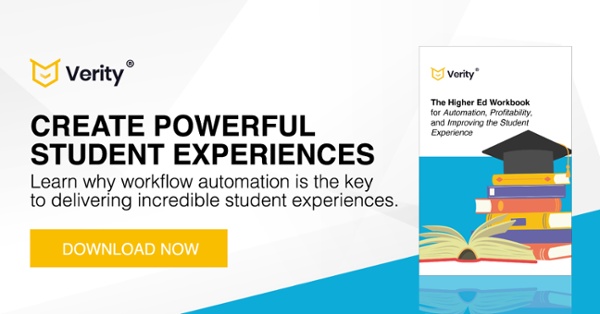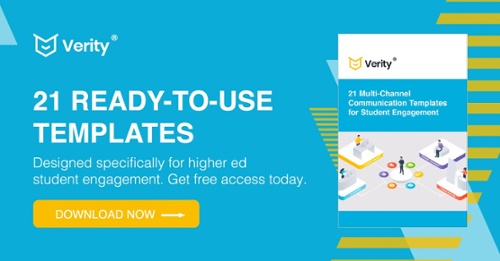How to Streamline Your Enrollment Management Process
Higher Ed professionals everywhere are looking for ways to streamline, modernize, and trim back what’s not working when it comes to enrollment management.
When you’re able to optimize these enrollment processes efficiently at your school, you can achieve a state where you’re:
- Automating class scheduling
- Having more insight (and intention ) into how you manage financial aid
- Providing more proactive support and guidance through academic advisors
- Increasing profitability
- Perhaps most important of all: building a stronger student experience
If you’re looking for ways to increase efficiency on your campus and streamline your operations (and let’s be honest, who isn’t?), then here are three enrollment management best practices you can follow.
How to Streamline Your Enrollment Management Strategy
Leverage Workflow Automation Wherever You Can
So much of what goes into enrollment management can be automated, so this is a great place to start. Not only will workflow automation create a better student experience, but it’ll also help make the lives of your team easier and free up time to work on other important tasks.
For example, you can use workflow automation to create triggers at critical junctures for your students. When they miss key deadlines or skip an advisor appointment, you can set up internal alerts, tasks for your team, and follow-up emails—all done automatically.
The list of how workflow automation can be used in Higher Ed institutions goes on and on, whether it’s class scheduling, disbursing financial aid, building proactive email communication workflows, or planning events.
If you need to set up an order of operations where tasks are dependent upon one another (think: signatures, approval, deadlines, etc.), then workflow automation can help you set up these foolproof processes.
Workflow automation also plays an important role in profitability! Read our blog, Why Workflow Automation and Profitability Go Hand in Hand, for more insights there.
Create Clear Content Pathways for Your Prospective Students
Recruiting and attracting prospects is a big part of enrollment management, and workflow automation can absolutely play a key role here. If you haven’t already, be sure to set up clear content pathways that offer valuable resources in a way that guides students naturally through their journey. It allows your prospective students to engage with you in a way that suits them best while establishing your school as a trusted, valuable guide.
So, what exactly is a content pathway?
Creating these pathways starts with providing helpful assets that provide value to most of your prospective students, who are at the top-of-the-funnel, “I’m just exploring my options” stage. Students at this part of their journey aren’t ready to speak with someone or start their application, so if you want them to convert on your site, you’ve got to give them something else to engage with.
Instead of only relying on “Apply Now” and “Request More Information” as your primary (or only) offers, create some premium content that your prospects will find irresistible. This can include things like:
- Career guides
- Student testimonials
- Video content
- FAQs
… Just to name a few.
And, an important thing to remember here is that there should be no dead ends, meaning that you should always be providing additional content, helpful resources, and other ways for them to continue exploring their options and learning about your school.
3 Enrollment Management Strategies You Can Implement Today
By offering up content along different stages of the student lifecycle, you’ll be able to gather valuable insights into the audience you’re attracting to and converting on your website.
If you’re getting lots of downloads on a career-focused guide but very few applications, for example, you’ll know that you need to create some kind of middle-of-the-funnel offer to help bridge that gap.
This will also help you segment your lists by key identifiers, such as program of interest, location, and, most importantly, where they are on their journey as a prospective student. Building segmented lists is a great way to quickly see who your contacts are and how you can best support them.
Use Multichannel Communication
Here at Verity, we’ve talked a lot about multichannel communication because we believe in it so strongly, and it especially rings true in enrollment management.
Everyone has their own preferences for communication channels, so it’s important to meet students (and parents when they’re at the suspect/prospect stage) where they are. Most commonly this should involve having a solid texting strategy because it’s the preferred channel for Gen Z and they have an astounding 98% open rate, compared to just 20% for emails. This will also help with summer melt, which can hurt your enrollment numbers if you’re not careful.
However, be sure to avoid these common mistakes when it comes to texting prospective students.
Leveraging multichannel communication will also help you streamline your decision-making when it comes to your approach to enrollment. You’ll be able to understand which channels your prospects prefer, see which emails get the highest open and click rates, and optimize your strategy for the future.
When you already know what works, you can move more quickly on planning campaigns, building assets, and executing your tasks that deliver results.
With your whole team able to streamline, what would that do for your workload? How would freeing up that time pave the way for more impactful programs that are fun, exciting, and inspiring to work on—not to mention creating incredible student experiences?
For more insights into how you can leverage multichannel communication, download our guide: 21 Multi-Channel Communication Templates. Inside, you’ll find real, usable templates that you can put into action today!



